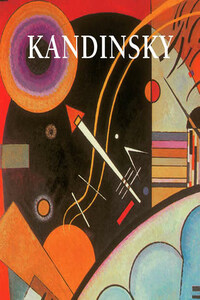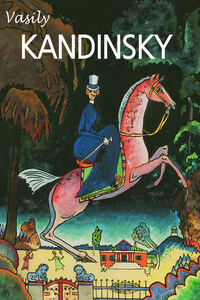1. Gouspiar, 1907. Oil on canvas, 18.5 × 18.9 cm. The State Tretyakov Gallery, Moscow.
Not long ago it seemed that this century had not only begun with Kandinsky, but had ended with him as well. However, no matter how often his name is cited by the zealots of new and fashionable interpretations, the artist has passed into history and perhaps belongs to the past and to the future to a greater degree than to the present.
Moreover, Kandinsky’s art does not reflect (or, if one may say so, is not burdened by) the fate of other Russian avant garde masters. He left Russia well before the semi-official Soviet esthetic turned its back on modernist art. He himself chose where he would live and how he would work. He was forced neither to struggle with fate nor to enter into conspiracy with it. His “struggles” took place “with himself” (Boris Pasternak). The persecutions to which “leftist” artists in Russia were subjected left him untouched and did not complicate his life. Neither, however was he was awarded a crown of thorns or the glory of a martyr, like the lot of those famous avant-garde artists who remained in Russia. His reputation is in no way obliged to fate – only to art itself.
The culture of the past was for him precious and intelligible: he was not concerned with the smashing of idols. Creating the new occupied him fully. He aspired neither to iconoclasm nor to scandalous behavior. It could hardly be said that his work lacked daring, but it was a daring saturated with thought, a polite daring that argued with art of the highest quality.
Educated in the European manner, a man of letters, a professional musician, and an artist much more inclined to reflection and to strict (but not altogether unromantic) logic than to loud declarations, Kandinsky preserved the dignity of a thinker, refusing to dissipate this dignity in petty quarrels within the artistic world. It has been said many times and said justly that the roots not only of Kandinsky’s art, but of his attitude to life in general, lay in Russia and Germany.
In intellectual terms, especially as concerns philosophy, Kandinsky was oriented towards the German traditions. But notwithstanding his interest in the past, he did not become its hostage, seeing in its wisdom the foundations for understanding and building the future. Kandinsky painted his earliest works when already a mature man.
Kandinsky was in the zenith of his fourth decade, a time in life when it is not easy to feel oneself a beginner. His first known canvasses date from the turn of the century: 1899 – Mountain Lake (M. G. Manukhina collection, Moscow); 1901 – Munich. Schwabing (The State Tretyakov Gallery), Akhtyrka. Autumn (Städtische Galerie im Lenbachhaus, Munich); c. 1902 – Kochel (The State Tretyakov Gallery). The painting Odessa – Port (late 1890s, The State Tretyakov Gallery), which opened the celebrated 1989 Kandinsky retrospective, already contained a certain magic.
2. Mountain Lake, 1899. Oil on canvas, 50 × 70 cm. Manukhina Collection, Moscow.
3. Munich, Schwabing, 1901. Oil on cardboard, 17 × 26.3 cm. The State Tretyakov Gallery, Moscow.
4. Achtyrka, Autumn, sketch, 1901. Oil on canvas, 23.6 × 32.7 cm. Städtische Galerie im Lenbachhaus, Munich.
5. Kochel (the Lake and the Hotel Grauer Bär), c. 1902. Oil on cardboard, 23.8 × 32.9 cm. The State Tretyakov Gallery, Moscow.
While that exhibition was still being prepared, amidst the abstract works or alongside the pictorial insights of Murnau, this painting seemed nearly dilettantish and almost Wanderesque. But next to it, any Wanderer landscape seemed passive and rooted in an impression taken from life. Of course, looking for the traits of future genius in the work of a neophyte is a very sly pursuit: it is easy to find what one wants to find instead of what is there.
Nevertheless, its elastically outlined, dark and radiant patches are much too independent of the object world; there is too much hidden tension in them which is unconnected with any real motif. The much too powerful drawing appears purely decorative alongside a fairly naive and traditional understanding of objective form. There is no doubt that this strict and powerful intellect had an emotional existence as well. For a beginning student, Kandinsky was much too mature.
Generally speaking, he had already gained a lot of knowledge as a result of his extensive reading and thinking. He had been to Paris and Italy, even giving Impressionism its due in his earliest works (as we have already mentioned). However, it was only in Germany that he aspired to study. It is obvious that in his preference for Munich over Paris, Kandinsky had been thinking more about schools than about artistic milieus. In any case, when Kandinsky had only just enrolled in the private school of Anton Azbè, renowned for its unswerving professionalism, Igor Grabar wrote (apparently, with good reason) that Kandinsky “ha[d] no ability whatsoever” and that “he ha[d] a very foggy notion of decadence.”









